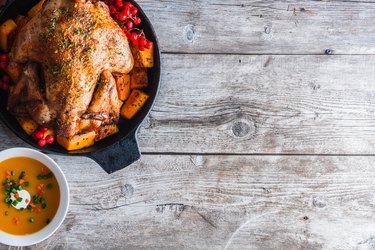
Cooking turkey overnight has somewhat gone out of fashion, but maybe it's time to bring back the trend. The overnight method buys you plenty of time for other party prep the morning of a festive gathering, without your having to wrestle a 15-pound bird at the crack of dawn. With just a few precautions, you can do this safely and enjoy beautiful results: a perfectly browned, moist turkey.
Warning
The U.S. Department of Agriculture urges home cooks not to cook turkey overnight, stating that bacteria can’t be killed when cooked under 325 degrees Fahrenheit. Other experts believe that a few precautions eliminate this issue. Proceed with caution if you choose an overnight turkey recipe.
Video of the Day
Safety First
It's not safe to roast a semi-thawed or frozen turkey. Unless you've bought a fresh bird, thaw the frozen turkey in the fridge beforehand – 12 hours for a small turkey and up to 24 for a larger one. Unwrap the frozen bird, season it internally and externally with pepper and salt, and put it in the refrigerator, uncovered, to dry out the skin. Setting the turkey in the roasting pan in this state will make the rest of the cooking process easier.
Your other safety "equipment"? Perhaps, most importantly, you need two thermometers: an oven thermometer to ensure that you slow-cook your turkey at 200F or at least 170F and a meat thermometer to check the final resting temperature of the roasted turkey.
In addition, make sure that your stuffing recipe is meant to be cooked outside of the turkey the day of the event. (With an overnight turkey recipe, stuffing is even more likely to form bacteria than when using the day-of roasting method.)
Start With a Hotter Temp
Not every overnight turkey recipe starts with briefly cooking the bird at a higher temperature, but if you include this step, you'll create a richer skin color on the finished turkey. More importantly, surface bacteria is killed when the turkey is cooked at a higher temperature for an hour or so. It becomes a "disinfectant" that makes up for the lower temperature used in the rest of the cooking.
Preheat the oven to 450F. If the turkey isn't already in the roasting pan to thaw, put it on its rack in the pan. Brush oil over the skin to ensure better browning; then place the turkey in the oven to cook at 450F for at least 45 minutes, but no longer than an hour.
Prepping the Turkey for “Bed”
Once the turkey has cooked at a bacteria-killing 450F for45 to 60 minutes, it's time to prep both the oven and the turkey for overnight roasting. Lower the oven's temperature to between 170F and 200F. Many ovens go as low as 170F to 180F, a temperature often recommended for this process, but cooking a turkey at 200 degrees will not dry it out.
Pull the roasting pan out of the oven and add about 1 quart of liquid to the roasting pan. Use plain water or apple cider blended with poultry seasoning. Drizzle the liquid over the bird first, allowing most of it to drip down the turkey and to the base of the pan under the rack.
Some cooks slow roast the turkey uncovered overnight, while others prefer to wrap the pan with aluminum foil to ensure moisture. It may take one or two turkey feasts for you to decide which method works best for you.
Set It and (Semi) Forget It
Now's the best part – going to bed while the bird cooks at the lower temperature. The rule of thumb for setting the timer is to allow about an hour of slow-roasting time for every pound of the turkey's weight.
But even with smaller birds, you needn't stay up late to time things just right. The hour-per-pound rule ensures only that the turkey cooks all the way through. But when slow-cooking a turkey at 200 degrees or a bit lower, it won't overcook. The bird will stay moist and heated rather than getting dried out or burnt.
Remove the turkey when your meat thermometer reaches about 160F in the breast and 170F in the thigh. Allow it to rest 20 to 30 minutes before serving.
Check out this related video from ExpertVillage on Youtube